Barrow-in-Furness
| Barrow-in-Furness | |
| Lancashire | |
|---|---|
| File:Barrow-in-Furness Main Image.jpg Barrow scenes | |
| Location | |
| Grid reference: | SD198690 |
| Location: | 54°6’39"N, 3°13’34"W |
| Data | |
| Population: | 59,182 (2001) |
| Post town: | Barrow-in-Furness |
| Postcode: | LA13-LA16 |
| Dialling code: | 01229 |
| Local Government | |
| Council: | Barrow-in-Furness BC |
| Parliamentary constituency: |
Barrow and Furness |
Barrow-in-Furness (commonly known as Barrow) is an industrial town and seaport at the tip of the Furness peninsula of Lancashire, on the north-western edge of Morecambe Bay. It is Lancashire's northernmost large town and the chief town of Lancashire North of the Sands.
Barrow stands amidst the seas, washed on the east by Morecambe Bay, to the west by the Duddon Estuary and all around by the Irish Sea. Its position has made it a leading industrial town, specialising in steel shipbuilding since the late nineteenth century.
The town centre and major industrial areas sit on a fairly flat coastal shelf, with a gentle incline leading away from the coast. Ten miles or so to the north-east is the southern edge of the Lake District.
In the Middle Ages, Barrow was a small fishing hamlet within the parish of Dalton-in-Furness. Furness Abbey, on the outskirts of the modern day town, controlled the local economy until its dissolution in 1537. A survey in 1843 found only 32 dwellings, including two pubs.
Barrow changed when the iron prospector Henry Schneider arrived in Furness in 1839 and, with other investors, opened the Furness Railway in 1846 to transport iron ore and slate from local mines to the coast. Further hematite deposits were discovered in 1850, of sufficient size to develop factories for smelting and exporting of steel. By the late 19th Century, Barrow was home to the largest steelworks in the world.[1] Barrow's natural sheltered harbour gave the new, booming town another opportunity; locally produced steel was used for shipbuilding.[2] By the 1881 census, Barrow's population had reached 47,000.
Barrow's location and the availability of steel made allowed the town to develop into a significant producer of naval vessels, a shift that was accelerated during First World War and the local yard's specialisation in submarines.
During World War II, Barrow was a target for the German air force looking to disable the town's shipbuilding capabilities.[3] The town suffered the most in a short period between April and May 1941. The difficulty in targeting bombs meant that the shipyards and steelworks were often missed, at the expense of the residential areas.
The original iron- and steel- making enterprises closed down after the Second World War, leaving Vickers' boat building factory as Barrow's main industry and employer. All of Britain's Vanguard class submarines, which carry Trident nuclear weapons, were built at the facility; the shipyard from the 1960s increasingly specialised in the construction of nuclear-powered submarines With the end of the Cold War and subsequent decrease in military spending the town suffered high unemployment, though the shipyard remains operational and the largest submarine production facility in the United Kingdom.
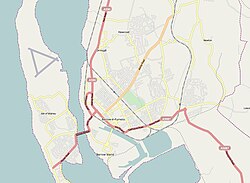
The town's name
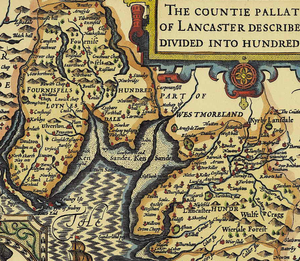
The name of "Barrow" was originally that of an island; the name 'Barrai' can be traced back to 1190. This was later renamed 'Old Barrow', recorded as Oldebarrey in 1537, and Old Barrow Insula and Barrohead in 1577. The channel silted up and the island joined to the mainland and the town took its name. The name itself seems to mean 'island with promontory', combining an original British name with barro- and Old English or Old Norse ey ("island").[4]
Islands
The town of Barrow-in-Furness is sheltered from the Irish Sea by Walney Island, a 14 mile-long island connected to the mainland by the bascule-type Jubilee Bridge. About 13,000 folk live on the isle's various settlements, mostly in Vickerstown, which was built to house workers in the rapidly expanding Vickers shipyard.
The principal islands off Barrow are:
- Walney Island (above)
- Barrow Island in the Walney Channel, now an island no longer since the channel was filed in to create land for the yard and now directly connected to the town.
- Piel Island, whose castle protected the harbour from marauders, particularly during the border wars.
- Sheep Island
- Roa Island
- Foulney Island
Churches
- Church of England: [1]
- .St Mary's Parish Church
- St Aidan's - Middlehill
- St Francis'
- St George's
- St James'
- St John's
- St Luke's
- St Mark's
- St Mary the Virgin
- St Matthew's
- St. Michael's
- St Paul's
- St Peter's
- St Peter's
- Baptist:
- Abbey Road Baptist Church, Abbey Road
- Emmanuel Community Church: Dalton Road [2]
- Methodist:
- Orthodox: The Community of St Simon the Zealot, Dalton-in-Furness
- Roman Catholic:
- Holy Family
- Our Lady of the Rosary and St Margaret of Scotland
- Sacred Heart
- St Anthony's - Askam in Furness
- St Columba's
- St Mary of Furness
- St Pius'
- Seventh-Day Adventist Church
- Spring Mount Christian Fellowship [6]
- The Salvation Army - Abbey Road
Architecture
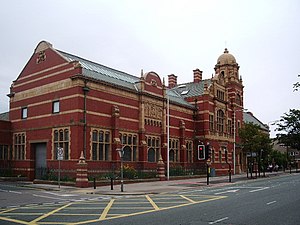
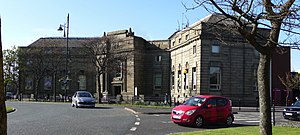
Barrow is one of Britain's few planned towns and has many fine buildings to show for it. There are many old and distinctive buildings in the town centre, mostly from the Victorian era, such as the town hall, old fire station, the 'Nan Tait' Centre, Salvation Army building and public library. There is also an increasing number of modern office buildings as well as the shipyard's cranes and construction halls which dominate much of Barrow's skyline. Barrow has 8 Grade I listed buildings, 15 Grade II* and 249 Grade II buildings.[5]
Proposed bridges
A number of new bridges in the Barrow area have been proposed. None has been begun. Discussions have gone on for many years on possible bridges across Morecambe Bay and the Duddon Estuary; the Build Duddon and Morecambe Bridges Party contested national elections in the Barrow and Furness constituency in 2005[6] Proposals include:
- A second bridge to Walney Island from mainland Barrow is planned to relieve congestion and as an aid to 24-hour access for the emergency services, most of which are based on the mainland.
- A 12 mile-long road bridge connecting Barrow to the Lancashire coast across Morecambe Bay. If built it would become one of the world's longest bridges. The proposal includes a tidal power generator.
- A 2-mile bridge crossing the Duddon Estuary linking Askam and Millom to improve transport links to the area
- A road and rail tunnel under the Duddon instead of a bridge.[7]
A link across the Duddon has been discussed more earnestly since the announcement that Kirksanton on the north side of the Duddon Estuary has been shortlisted as a site for a new nuclear power station.[8]
Economy
Shipyard
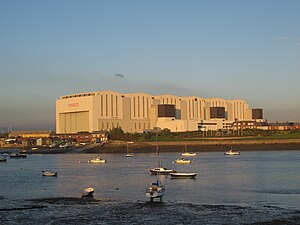
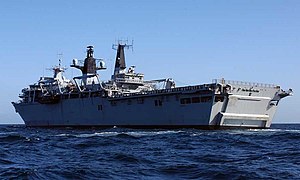
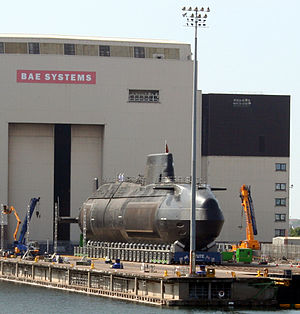
The BAE Systems Submarine Solutions shipyard at Barrow is one of the largest shipyards in Britain. It was expanded in 1986 by construction of a new covered assembly facility, the Devonshire Dock Hall (DDH), completed by Alfred McAlpine plc, on land that was created by infilling part of the Devonshire Dock with 2.4 million tons of sand pumped from nearby Roosecote Sands.[9] DDH is the tallest building in Barrow and stands at 167 feet. With a length of 879 feet, a width of 167 feet and an area of 270,000 square feet, it is the second largest shipbuilding construction complex of its kind in Europe.[10][11]
BAE Systems has obtained planning permission for a new Central Assembly Shop dubbed 'Son of DDH' which will provide over 700 new jobs, initially in construction of a large section of the new Queen Elizabeth class aircraft carriers. (hull lower block 3).[12][13]
Despite the large fall in numbers employed by the shipyard, Barrow retains a high proportion of workers in the manufacturing industry. In September 2008, Barrow was named as the most working class location in the United Kingdom, based on a series of measures devised to judge the lifestyle of the people. Ironically in the 1870s Barrow had more aristocrats per head than anywhere else in the county.[14]
The shipyard does not build submarines exclusively: it undertook fitting out and commissioning of helicopter carrier HMS Ocean in the mid-1990s (although the ship was built by Kværner in Govan, Glasgow), and construction of the tanker RFA Wave Knight and Albion Class amphibious assault ships HMS Albion and HMS Bulwark.
Other
Associated British Ports Holdings owns and operates the Port of Barrow, which can berth vessels up to 660 feet long and with a draught of 33 feet. Principal traffic includes the export of condensate by-product from the production of gas at the Rampside Gas Terminal, wood pulp, and locally quarried limestone which is exported to Scandinavia for use in the paper industry. The port, which has deep water access, also handles the shipment of nuclear fuels and radioactive waste for BNFL's Sellafield plant on the coast of Cumberland.[15]
In 1985, gas was discovered in Morecambe Bay, with the products processed onshore at the gas terminal in Rampside, south of the town.[16] A new 30 turbine wind-farm which has recently been built in the Irish Sea off the coast of Walney Island, although the electricity generated is sent by undersea cable to Heysham.
James Fisher & Sons plc, a service provider in all sectors of the marine industry and a specialist supplier of engineering services to the nuclear industry in the United Kingdom and abroad,[17] was founded in Barrow in 1847.[18] Annual revenue stood at almost £90 million in 2007 (up 55% from £57 million in 2006), as well as staff numbers standing at over 1,000 worldwide, with 120 of those in the Barrow headquarters.[19]
Other major employers include the National Health Service (Furness General Hospital, which employs 1,800 staff)[20] and the Kimberly Clark paper mill which has 400 employees.[21] Amongst many retailers that have established themselves in Barrow, the furniture store Stollers is noted as being one of the largest shops of its kind in Britain.
Employment
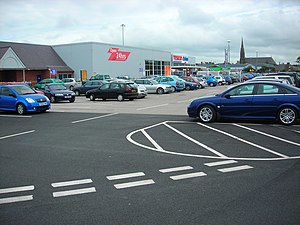
The 2001 Census gave the total working population of Barrow as follows. (The + or - signs at the end indicate whether the percentge employed in that sector is slightly higher +, much higher ++, slightly lower- or much lower—than England's average.[22])
- Manufacturing - 8,087 employed (28.03% of the town's working population) ++
- Retail: 4,671 (16.19%) -
- Health and Social Work: 3,635 (12.60%) ++
- Real estate, renting and business activities: 1,852 (6.42%) –
- Construction: 1,797 (6.23%) -
- Education: 1,765 (6.12%) -
- Hotels and Catering: 1,730 (6.00%) ++
- Transport Storage and Communication: 1,490 (5.16%) -
- Public Administration and Defence: 1,427 (4.95%) -
- Other: 1,179 (4.09%) -
- Finance: 471 (1.63%) –
- Electricity, Gas and Water supply: 379 (1.31%) +
- Agriculture: 252 (0.87%) -
- Fishing: 8 (0.03%) +
Tourism
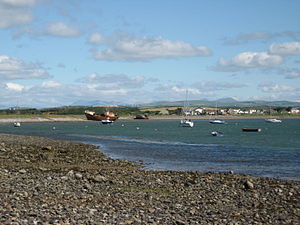
Barrow in Furness is not a primary tourist destination in itself. Nevertheless, since it is only about 20 minutes by car from the Furness Fells, attempts have been made to market it as a Gateway to the Lakes".[23] A new marina complex has been built and a cruise ship terminal is planned, intended to boost visitor numbers.[24]
Barrow's own attractions, include:
- The Dock Museum, which tells the history of Barrow's shipbuilding, built on and around the old graving dock.
- An indoor market, with a broad variety of stalls.[25][26]
- Walney Island with two nature reserves and with golf courses.
- Furness Abbey ruins on the outskirts of Barrow; once the second richest and most powerful Cisterian abbey in England.
As the major town of Lancashire north of the sands and serving parts of Westmorland also, Barrow is the area's premier shopping town[27] It also has leisure facilities, restaurants, a cinema and out-of-town retail parks
Dialect
The Furness dialect is a Lancastrian type, quite different from those of nearby Cumberland and Westmorland. As with Liverpool, the Barrovian dialect has been influenced by large numbers of settlers from various regions. The town only developed from a small mining and fishing village in the late nineteenth century, and the birth of the steelworks and shipbuilding industries drew large numbers on incomers. Workers came from Glasgow and the Clyde, from the shipyards of the Tyne and other thriving shipbuilding centres. The result has been a local dialect with a rich mixture of influences from Glasgow, the Geordie dialects and from the rest of Lancashire amongst others.
In general it is observed that the Barrovian dialect tends to drop certain letters (including h and t, as in Cockney speech), and gives more emphasis to the stressed vowels.
References
- ↑ Barrow Steelworks
- ↑ Barrow Museum Mission Statement, The Dock Museum Website. URL accessed 11 December 2006.
- ↑ "The Battle of Britain - Diary - 2 September 1940". RAF. 16 February 2005. http://www.raf.mod.uk/bob1940/september2.html. Retrieved 5 August 2007.
- ↑ Mills, David (1976). The Place Names of Lancashire. London: Batsford Books. ISBN 0 7134 3248 9.
- ↑ "Listed Buildings". Barrow Borough Council. http://www.barrowbc.gov.uk/default.aspx?page=2758. Retrieved 16 August 2007.
- ↑ "Timothy Bell". London: The Guardian. http://politics.guardian.co.uk/person/0,,-10353,00.html. Retrieved 2 February 2008.
- ↑ http://www.nwemail.co.uk/news/viewarticle.aspx?id=203923 nwemail.co.uk
- ↑ http://www.nwemail.co.uk/news/landmark_announcement_for_new_nuke_power_station_1_630028?referrerPath=news/millom
- ↑ The Road to Success: Alfred McAlpine 1935 - 1985 page 174, Tony Gray, Rainbird Publishing, 1987
- ↑ BAE Systems Press Release
- ↑ IHC Merwede
- ↑ "FACTSHEET: The Royal Navy's Future Aircraft Carriers". Ministry of Defence. 25 July 2007. http://www.mod.uk/DefenceInternet/FactSheets/EquipmentFactsheets/FactsheetTheRoyalNavysFutureAircraftCarriers.htm. Retrieved 23 September 2007.
- ↑ "Go-Ahead for Son of DDH". North West Evening Mail. 14 August 2007. Archived from the original on September 26, 2007. http://web.archive.org/web/20070926211131/http://www.nwemail.co.uk/news/viewarticle.aspx?id=531927. Retrieved 15 August 2007.
- ↑ http://www.nwemail.co.uk/news/barrow/1.244620
- ↑ "Port of Barrow". Associated British Ports. http://www.abports.co.uk/custinfo/ports/barrow.htm. Retrieved 20 August 2007.
- ↑ "About Us". Centrica Gas. http://www.centrica.com/index.asp?pageid=459. Retrieved 21 July 2007.
- ↑ "Welcome to James Fisher". James Fisher official website. James Fisher and Sons. 2005. http://www.james-fisher.co.uk/. Retrieved 30 August 2007.
- ↑ MacIsaac, Mary (6 April 2003). "With a fair wind blowing there are profits to be made on the high seas". Armchair Investor (The Scotsman). http://business.scotsman.com/topics.cfm?tid=895&id=401272003. Retrieved 30 August 2007.
- ↑ "Jobs Hope as Fisher Booms". North West Evening Mail. 29 August 2007. Archived from the original on September 26, 2007. http://web.archive.org/web/20070926212059/http://www.nwemail.co.uk/news/viewarticle.aspx?id=536629. Retrieved 30 August 2007.
- ↑ "Cumbria Prosperity Priorities Summit held on 2 April 2004" (DOC). North West Regional Assembly. http://www.nwra.gov.uk/downloads/documents/imported/321089760698.doc. Retrieved 20 August 2007.
- ↑ "Furness Enterprise - Fast Moving Consumer Goods". Furness Enterprise. http://www.furnessenterprise.co.uk/furness_enterprise_sectors.asp?menuID=13&ID=IS6. Retrieved 20 August 2007.
- ↑ "Industry of Employment". www.statistics.gov.uk. http://neighbourhood.statistics.gov.uk/dissemination/LeadTableView.do?a=3&b=276911&c=LA14+3LD&d=13&e=9&g=431977&i=1x1003x1004&o=1&m=0&r=0&s=1198951042328&enc=1&dsFamilyId=27. Retrieved 29 December 2007.
- ↑ "Half Term Fun for the Kids Just on the Doorstep". North West Evening Mail. 17 February 2007. http://www.nwemail.co.uk/news/viewarticle.aspx?id=467814. Retrieved 14 August 2007.
- ↑ "November 2005 - Executive Committee Agenda" (DOC). Barrow Borough Council. November 2005. pp. 5. http://www.barrowbc.gov.uk/docs/November%202005%20-%20Executive%20Committee%20Agenda.doc. Retrieved 14 August 2007.
- ↑ van der Zee, Bibi (7 August 2007). "Pitch Perfect, Part Two". London: The Guardian. Archived from the original on July 2, 2007. http://web.archive.org/web/20070702120519/http://www.guardian.co.uk/g2/story/0,,1838907,00.html. Retrieved 27 July 2007.
- ↑ "Barrow Borough Council - Barrow Markets". Barrow Borough Council. 7 March 2007. http://www.barrowbc.gov.uk/default.aspx?page=149. Retrieved 27 July 2007.
- ↑ "Barrow-in-Furness Tourist Information". AboutBritain.com. http://www.aboutbritain.com/towns/barrow-in-furness.asp. Retrieved 25 August 2007.